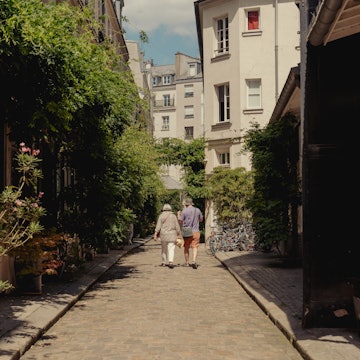

Visit the spectacular Mezquita mosque in Córdoba. maziarz/Shutterstock
Seville, a city packed with a fascinating history and incredible architecture, is sure to seduce you. But once you've ticked everything off your must-visit list, it's time to look beyond the city limits to find new travel inspiration.
Head to a historic city like Córdoba, wander through the pretty streets of the pueblos blancos (white towns) such as Ronda and Arcos de la Frontera, or get comfortable and relax on the beaches of Cádiz. These are the best day trips within easy reach of Seville.
1. Follow in the footsteps of pilgrims to Córdoba
Travel time: 45 minutes by train, 1 hour 40 minutes by car
The must-see sight of the 10th-century Islamic caliphate of Córdoba is the Mezquita, the magnificent Moorish-era mosque, where a forest of columns topped with striped arches was designed to look like palm trees. Since the 16th century, the Mezquita has contained a Christian cathedral within (be sure to buy entry tickets in advance).
The city is also famous for its alleyways and courtyards lined with joyously colorful potted plants; the Palacio de Viana, an art museum in a Renaissance palace, has 12 patios of floral delight. Foodies shouldn’t miss Michelin-starred Noor, which champions Andalusian cuisine (only pre-Columbian dishes – no New World ingredients).
How to get to Córdoba from Seville: Trains to Córdoba leave from Santa Justa station – the journey takes 45 minutes by high-speed AVE, or 1 hour 20 minutes by regional train. By car, it’s straight up the A4 motorway (around 1 hour 40 minutes).

2. Step onto the set of a Bond movie in Cádiz
Travel time: 1 hour 20 minutes by train, 1 hour 40 minutes by car
Possibly Andalucía’s most offbeat provincial capital, Cádiz is known for its anarchic, independent-minded residents and their satirical songs and full-on partying at its annual Carnival in February. Founded by the Phoenicians around 1100 BCE, it's one of Europe's oldest settlements. If the Playa de la Caleta looks familiar, that’s because you saw its golden sands – as well as the digitally-edited 16th-century fortress Castillo de Santa Catalina next door – in the Bond movie Die Another Day, when Cádiz doubled as Havana.
The city’s old center is a maze of timeless streets and squares with faded mansions and fabulous fish restaurants, the local favorite being El Faro. Check out the raw ingredients at the Mercado Central de Abastos, which has more than 50 seafood stalls, before sampling some tapas and sherry in the Rincón Gastronómico, or digging your toes into the sand at a chiringuito (beach restaurant).
How to get to Cádiz from Seville: Catch a train to Cádiz from Santa Justa station (1 hour 40 minutes); alternatively, it’s 1 hour 20 minutes by car on the AP4 motorway.

3. Enjoy spectacular views in Ronda and the white towns
Travel time: 2 hours 20 minutes by bus, 1 hour 50 minutes by car
The pueblos blancos (white towns) are a delight to explore, with moody streets twisting past whitewashed houses, crumbling castles and imposing churches. Ronda's spectacular location atop El Tajo gorge, carved out by the Río Guadalevín, and its dramatic history littered with outlaws, bandits, guerrilla warriors and rebels has made it a popular tourist destination, especially from the coast.
North of Ronda, other white towns include Olvera with its magnificent castle, and Setenil de las Bodegas, located deep in a gorge with streets under overhanging rocks. Arcos de la Frontera, to the east, is spectacular too, with its dramatic clifftop location and mysterious old town.
How to get to the white towns from Seville: Ronda is about 1 hour 50 minutes by car from Seville (A-375/A-374), or 2 hours 20 minutes by bus from the Prado de San Sebastian; Arcos de la Frontera is about 1 hour 15 minutes away by car (AP4/A-382). Tours are available from Seville.

4. Sip sherry in a bodega in Jerez de la Frontera
Travel time: 1 hour by train, 1 hour 15 minutes by car
Did you know that sherry can only be produced in three towns? The capital of the “Sherry Triangle” is Jerez, with 90 bodegas, of which you can visit 50. On a tour you will learn about the unusual technique by which this fortified wine is blended and aged, and the influence of soil and climate, before the best part: tasting various delectable sherries. Bodegas Tradición has a private art collection, so you can admire works by Goya and Velázquez while sipping your golden, nutty amontillado or pale, dry manzanilla.
How to get to Jerez from Seville: The train from Santa Justa station to Jerez takes an hour. If you're skipping the wine, the drive on the AP4 motorway is slightly longer at 1 hour 15 minutes.

5. Explore spectacular caves in Aracena
Travel time: 1 hour 30 minutes by bus, 1 hour 15 minutes by car
Aracena is a charming rural market town wrapped around a medieval hilltop church and a ruined castle. Wander sloping streets and burbling streams, or venture inside the Gruta de las Maravillas, a series of spectacular limestone caves. Aracena is a great launching pad for exploring the Sierra de Aracena hill country, which is full of walking trails, stone villages, castles – and the famous pata negra (acorn-munching pigs).
How to get to Aracena from Seville: Aracena is around 1 hour 15 minutes by car from Seville (A66/N433), or an hour and a half by bus from Plaza de Armas.

6. Learn about Moorish heritage in Granada
Travel time: 2 hours 30 minutes by train, 3 hours by car
It'll require an early start and it could mean a late return, but a day in Granada's contrasting neighborhoods of energetic streets and peaceful hillside cármenes (villas with walled gardens) will leave a lasting impression. Sprawled at the foot of the Sierra Nevada, the city was the last stronghold of the Moors in Spain and their influence is still evident everywhere. One of the most spectacular sights of all is the Alhambra, an astonishing palace complex towering over the city, whose Islamic decor and landscaped gardens are unrivaled in Europe. Book your timed entry well in advance.
How to get to Granada from Seville: The fast train from Seville Santa Justa can get you to Granada in around 2 hours 30 minutes; it's nearer three hours to drive on the A92. A guided tour is a good option to help you make the most of the city.















